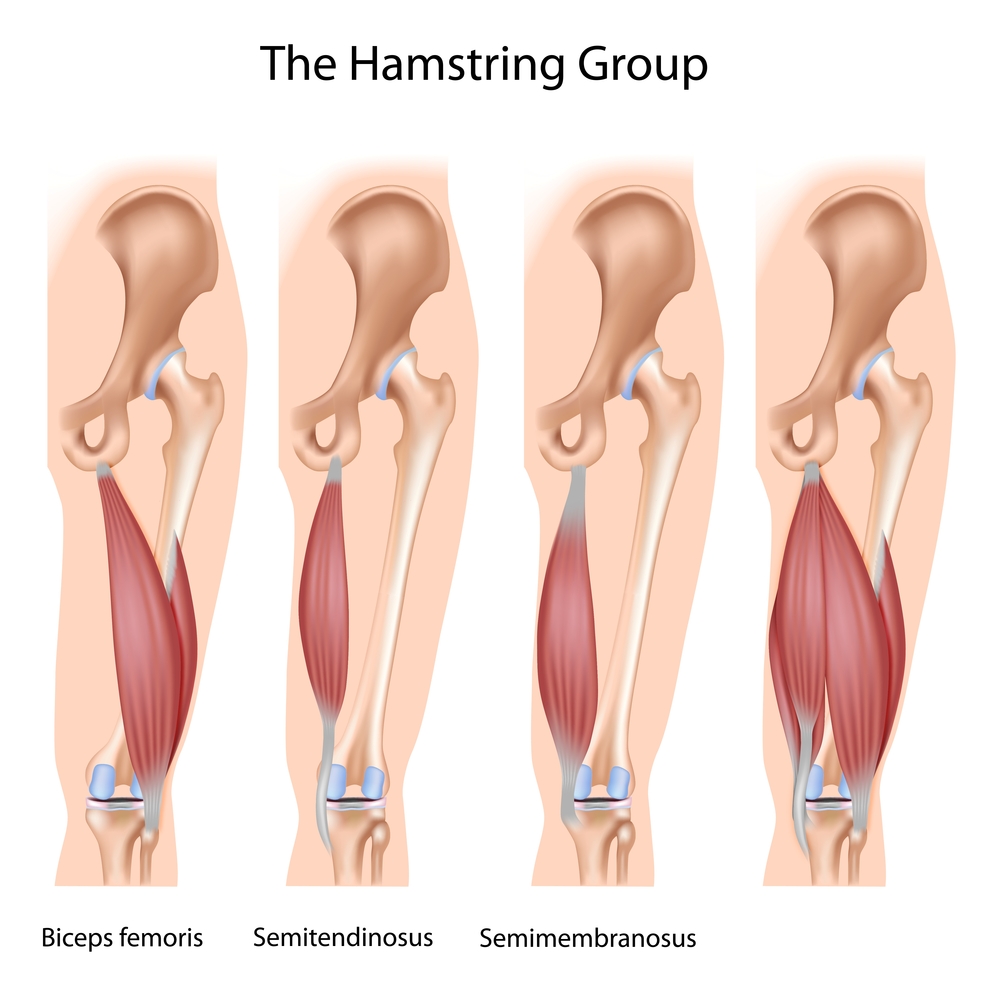Your Injury
- Abdominal Injuries
- Achilles Tendon Injuries
- Ankle Injuries
- Back Pain Lumbar Spine (Low)
- Back Pain Thoracic Spine (Middle)
- Buttock Pain
- Calf Pain
- Elbow Pain
- Foot Pain
- Groin Injuries
- Hamstring Injury
- Hand and Finger Injuries
- Headache
- Hip Pain
- Knee Injuries and Knee Pain
- Neck Pain
- Numbness, Tingling and Nerve Pain
- Thigh (Quadricep) Injuries
- Sciatica
- Shoulder
- Shoulder Blade (Scapula) Pain
- Toe Pain
- Wrist Injuries
Hamstring Injury
Hamstring Muscle Injury or Strain (Tear)
What is a hamstring muscle strain?
The hamstring muscle group is made up of three muscles, the semimembranosus, semitendinosus and biceps femoris. Their main function is to flex (bend) your knee and extend your hip. They also help with the position and stability of your pelvis. Hamstring injury is commonly seen in sprinters, hurdlers and long jumpers.
What causes a hamstring muscle strain?
Hamstring injury is common in sports involving high speed running, accelerating, decelerating and kicking e.g. soccer, AFL, tennis. Common underlying conditions contributing to this injury are a decreased range (flexibility) of the hamstring group, dysfunction of the low back and an altered position of your pelvis. Quite often, the hamstring will fail when contracted with excessive force in a stretched position, during running or sprinting just before or after the foot hits the ground. In this situation, the hamstring muscle group is stretched over the back of the hip and knee joints whilst it is working hard to slow down the forward swinging leg and secondly propel your body forward.
How does a hamstring muscle strain feel?
A sudden pain in the back of the thigh or a ‘tearing’ sensation. With a minor strain, you may be able to continue participation with minimal restriction. However as the muscle cools down following activity, pain may gradually increase as bleeding and swelling around the injured muscle continues. This may be associated with progressive tightening and stiffening of the hamstring muscle group. With severe strains, you will be unable to continue participation due to excessive pain. Obvious swelling and a visible defect in the muscle is quite common with large tears.
Management of a hamstring muscle strain and how to fix it
With all levels of hamstring injury, stop your activity immediately and start initial treatment. Treatment of any injury is best commenced in the first 24-48 hours. The RICE regime should be commenced (rest, ice, compression and elevation) as this will reduce blood flow, swelling and pain.
You should continue the RICE regime until you consult a sports medicine professional, preferably within 2 days of the initial injury. The assistance of a sports medicine professional is important in the treatment of a hamstring muscle strain to determine the extent of tissue damage and how long the injury is expected to take to heal. Specialised treatment techniques to assist in reducing pain and swelling and enhance the healing of the injured structures will be administered. This will include an appropriate progression of exercises aimed at increasing range of motion, strength and function. These exercises will speed up your return to sport participation and, by identifying the reason why you tore your hamstring, to help prevent reinjury.
Hamstring insertional tendinopathy
What is hamstring insertional tendinopathy?
This is an irritation or degeneration of the tendon of a hamstring muscle at its attachment to the ischial tuberosity (buttock).
What causes hamstring insertional tendinopathy?
Hamstring origin tendinopathy results from overuse of the hamstring tendon, at its origin in the buttock. The function of the hamstring tendon is to transmit forces produced by the large muscle group on the back of the thigh (hamstrings) to the pelvic bone complex. Repetitive use of the hamstring muscle group and, therefore, the hamstring tendon can lead to microscopic tears within the tendon.
How does hamstring insertional tendinopathy feel?
Pain felt deep into the lower part of the buttock usually develops with no specific incident. Initially the pain may only be present following exercise. Associated with this pain may be tightness in the hamstring muscles. Typically, these initial signs of hamstring origin tendinopathy are ignored, because the ease with activity. As you continue to participate in sport, the tendinopathy progresses and the pain becomes more intense and more frequent. As the condition worsens the pain may begin to be present for longer periods during participation until it is present all of the time and may interfere with your performance.
Management of hamstring insertional tendinopathy and how to fix it
Hamstring origin tendinopathy often does not improve on its own, especially if the cause is not addressed and you continue to exercise. Physiotherapy can assist in diagnosis and creating a rahabilitation program which may involve activity modification, soft tissue treatment such as massage and stretching, and the progression through a series of specific strengthening exercises. Exercises appropriate to a recovery from this condition need to be of a task specific nature so that the injured structures have adapted to the forces and demands of returning to pre injury activities. The physiotherapist will also be able to assess and determine why you developed this injury and address prevention of re-occurrence when you return to full activity.




